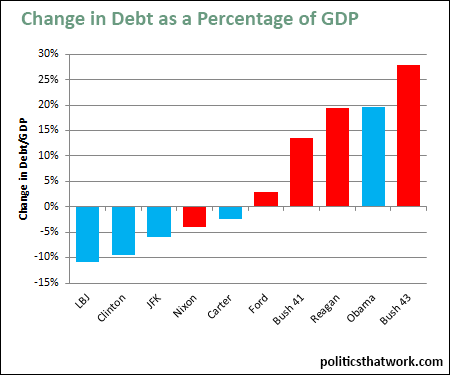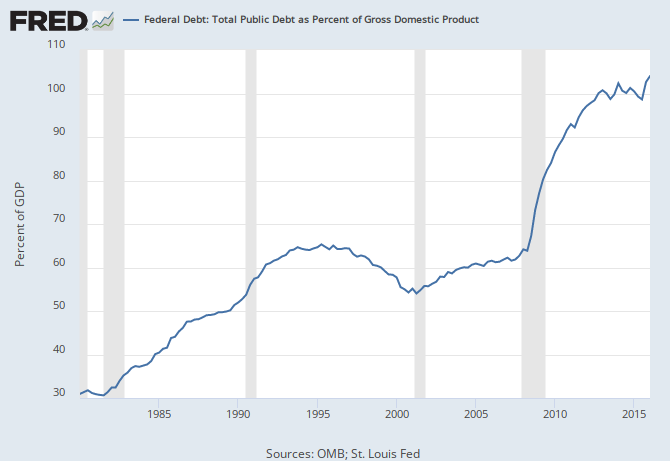Think about what you just said, me boy. After the economy loved Reagans economic measures to the point that the UE went to the second highest in US history, he spent the next 6.5 years increasing taxes and TRIPLING THE NATIONAL DEBT. (bold and red to try to get you to understand). And the economy responded as any thinking person would have thought.
So, yes indeed, you might try to listen to economists and stop posting conservative dogma. It is SO boring, and largely ignorant.
After the economy loved Reagans economic measures to the point that the UE went to the second highest in US history
You never showed the spending cuts you're blaming for the jump in unemployment.
I guess your claims are dead on arrival.
Yes I did, You are lying, me con tool.
he spent the next 6.5 years increasing taxes
Yup, raised the top rate from 70% all the way up to 28%.
You know better, me boy. He lowered income tax rates at the highest rates. But he also raised taxes in other areas 10 or 11 times.
Do you disagree?
and
TRIPLING THE NATIONAL DEBT.
Yup, Reagan added $1.8 (
in 1982 dollars) trillion, won the Cold War
(Was there for the end, and gave no credit to every other presidents policies) and gave us massive growth in jobs and GDP.
(and proved, again, that Keynesian policies work).
Obama added $8.6 trillion(Resulting from the Great Republican Recession) so far, made us weaker around the world and gave us the weakest economic recovery in history.
The gross debt increase in 2009 was huge, because of the decreased tax revenues and increased benefit payments caused by the Great Recession.
Two other large contributors to debt since 2009 are the government’s continued borrowing to fund military operations in the Middle East and increasing costs of the health system, said Linda Bilmes, an expert in national budgetary issues at Harvard University. Both of these were a result of previous administrative policies and external factors.
Rand Paul: Debt doubled under Bush, tripled under Obama
Since President Barack Obama first took office:
- Homicides have dropped 13 percent, but gun sales have surged.
- The economy has added more than 9 million jobs, and the jobless rate has dropped to below the historical median.
- The number of long-term unemployed Americans has dropped by 614,000 under Obama, but it is still 761,000 higher than at the start of the Great Recession.
- Corporate profits are up 166 percent; real weekly wages are up 3.4 percent.
- There are 15 million fewer people who lack health insurance.
- Wind and solar power have nearly tripled, and now account for more than 5 percent of U.S. electricity.
- The federal debt has more than doubled — rising 116 percent — and big annual deficits have continued.
Number of Jobs — The economy has added 851,000 jobs since we published our last report. As of December, the number of total nonfarm jobs stands
9,265,000 higher than when Obama first took office.
That compares with the nearly 23 million jobs gained during the booming years of Bill Clinton’s presidency, and the fewer than 1.3 million added during President George W. Bush’s eight years, which were plagued by two recessions.
Unemployment Rate — Meanwhile the unemployment rate went down again, to 5.0 percent. It’s now 2.8 percentage points lower than it was in January 2009, when the president first took office in the midst of the worst economic downturn since the Great Depression.
Historically, the jobless rate is significantly lower than it has been most of the time since 1948. The historical median is 5.6 percent.
Long-term Unemployment — The number of long-term unemployed — those who have been looking for work for 27 weeks or longer — has dropped further since our last report. The number went down to less than 2.1 million in December, which is 614,000 fewer than when the president first took office. But it is still 761,000 higher than it was in December 2007, at the start of the Great Recession.
Labor Participation Rate — The labor force participation rate, which is the portion of the civilian population that is either employed or currently looking for work, ticked upward since our last report, to 62.6 percent in December. But it is still 3.1 percentage points lower than when Obama took office.
Contrary to many of Obama’s critics, however, that decline is due mostly to factors outside the control of any president — factors such as the post-World War II baby boomers reaching retirement age. Survey data published by the Bureau of Labor Statistics in December show that those outside the labor force in 2014 said their reasons for not working were retirement (44 percent), illness or disability (19 percent), school attendance (18 percent) or home responsibilities (15 percent). Only 3 percent said they couldn’t find a job, or gave some other reason.
Obama’s Numbers (January 2016 Update)



